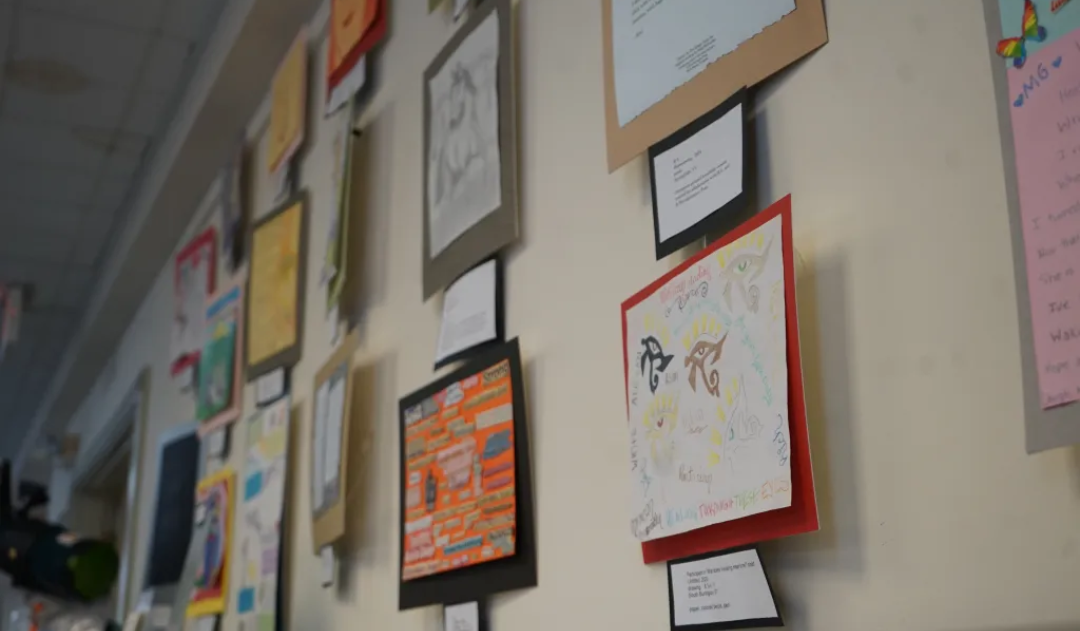Work of Incarcerated Artists Travels Through Vermont in ‘Finding Hope Within’ Exhibit

Finding Hope Within features art that has emerged through the carceral system in Vermont. The work featured in this exhibition includes drawings, mixed media, poetry and narrative writing by incarcerated artists at the Chittenden Regional Correctional Facility in South Burlington. The exhibition is cocurated by Heather Newcomb of Vermont Works for Women, Ashley Messier of Vermont Women’s Justice and Freedom Initiative, and A Revolutionary Press in collaboration with the artists and poets at the Chittenden Regional Correctional Facility.
the bridge | July 9, 2024
By: Alex McPhedran, via Community News Service, a University of Vermont journalism internship.
On a wall at Montpelier’s Center for Arts and Learning hangs a pencil drawing of a horse and, below that, a placard for the artist’s name. “C.C.” is all it lists. The piece rests among colorful images of natural scenes, portraits, collages and drawings accompanied by short poems.
All of those works provide only the initials or less of the artists who created them.
That’s because the entire gallery exhibit, “Finding Hope Within,” was created by women incarcerated at Chittenden County Regional Correctional Facility. The artists can’t have their names used in the program because, curators said, the Vermont Department of Corrections doesn’t allow it.
The project came to fruition during the COVID-19 pandemic in 2020.
“Access to the outside world was really limited, and we had no volunteer program happening. It was really just us contractors who were allowed to still come into the facility and interact with the women,” said Heather Newcomb, co-curator of the exhibit and program manager for Vermont Works for Women’s justice-involved services. “I really saw the women missing that creative outlet.”
The art proved cathartic for the women making it. It provided them a way to expel anxieties and express hopes in a way words wouldn’t allow.

Crocheted items in the “Finding Hope Within” exhibit in Richmond. Photo by Alex McPhedran
“Art is just a way for them to express how they’re feeling and process those emotions,” Newcomb said, “so that way they aren’t avoiding them or stuffing them down to where they build up and cause pressure, then explode.”
Beyond providing an emotional and psychological outlet for the women, the artwork can offer the humaneness often denied to people in the carceral system, organizers say.
“It’s a way of recognizing someone’s humanity. Often in prison situations, we think the best way to do things is to deny people their humanity,” said gallery co-curator John Vincent, founder of A Revolutionary Press, a letterpress print studio.
He framed the idea behind the exhibit in terms of what society aims to achieve when it puts people in prison. Most of those people will get released and need to reintegrate into a community.
“How would we like them to be when they come back?” Vincent asked. “In worse shape than they were when they went because of inhumane conditions and treatment and a lack of being able to express themselves, or alternatively they come back and they’re writing poetry and haikus, and doing artwork?”
The exhibit contains a range of work in different mediums, including thematic collages of words and pencil-drawn scenes of healing, all the way to crocheted dresses and tapestries.
The pieces seem to convey the complex emotions that can accompany incarceration — and the relief from trauma that expression can provide.

A poem on display as part of “Finding Hope Within.” Photo by Alex McPhedran
The exhibit, in a few different forms, has been shown around for the last several years. The installation was at the Richmond Free Library earlier this year, then it moved to the Center for Arts and Learning in Montpelier on March 19.
“We’re having that up there in the legislative season, hoping that we can get legislators to come down and look at artwork by people who are incarcerated,” Vincent said. “It’s a way to shift people’s minds and perceptions about who people are in prisons.”
Visitors can visit the center and view the exhibit Monday through Saturday, 8 a.m. to 8 p.m., until it moves on from Montpelier on April 28.
“I just want people to understand that there’s people in those buildings,” Newcomb said. “They’re not criminals, they’re not addicts, they’re not offenders — they’re people first.”